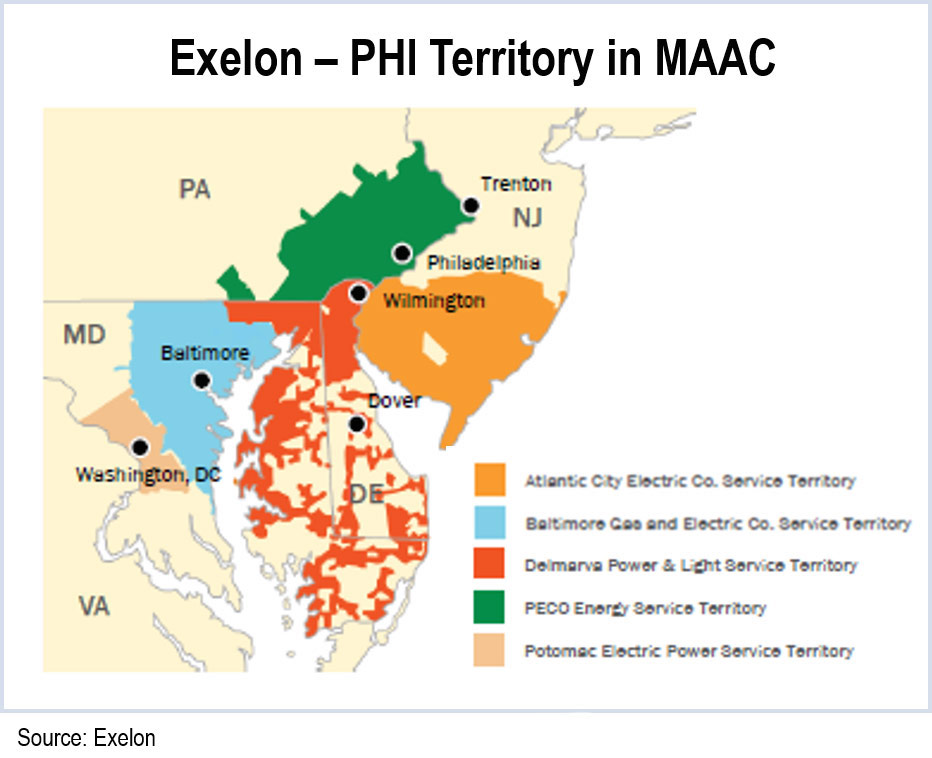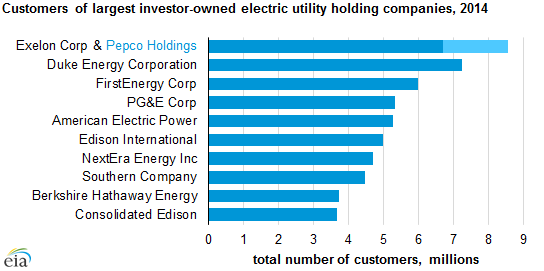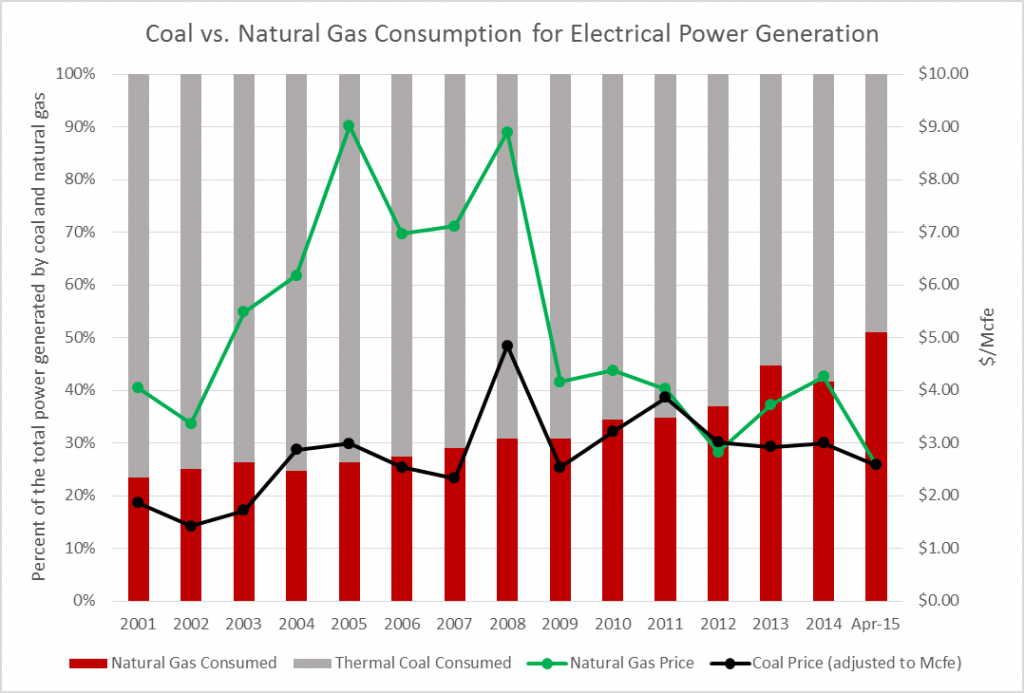Combined Exelon, Pepco utility will have the largest customer base in the U.S.
Support from District of Columbia Mayor Muriel Bowser for the merger of Exelon (ticker: EXC) and Pepco Holding Inc. (ticker: POM) utilities may push the $6.8 billion merger through, even after the D.C. Public Service Commission (PSC) announced it would not approve the deal in August. The deal would bring together Exelon’s three electric and gas utilities – BGE, ComEd and PECO – and Pepco’s electric and gas utilities – Atlantic City Electric, Delmarva Power and Pepco – to create a Mid-Atlantic electric and gas utility with a rate base of approximately $26 billion.
The companies announced a definitive agreement to combine on April 30, 2014, in an all-cash transaction valued at $6.8 billion. The combined utility would serve roughly 8.6 million customers, making it the largest in the country, according to the Energy Information Administration (EIA).
When Exelon proposed purchasing Pepco Holdings, the company cited cost reductions available through increased scale and the two companies “geographic proximity and similar utility business models” as the primary reasons for the merger. Many U.S. investor-owned utilities (IOUs) have consolidated in recent years, often under the umbrella of a corporate holding company structure.
IOUs, such as ComEd, Pepco, and BGE, are the primary providers of electricity to retail customers and are subject to state and federal regulatory oversight. One important piece of legislation that influenced the power industry for decades was the Public Utility Holding Company Act of 1935 (PUHCA), which limited IOUs to operating within a single state and prevented the companies from diversifying into unregulated types of businesses. The Energy Policy Act of 1992 relaxed the strict requirements of PUHCA regarding holding company corporate structures in the electric power and natural gas utility industries. A number of states required their utilities to divest their generation assets to affiliates or to independent power producers. In addition, some states introduced retail competition to their electricity customers. The Energy Policy Act of 2005 repealed most components of PUHCA. Since then many IOU holding companies have merged.
 Shifting opinions in D.C.
Shifting opinions in D.C.
The deal received approval from shareholders, the Maryland PSC, New Jersey, Delaware, and from the Federal Energy Regulatory Commission (FERC) before the D.C. PSC said it would not support the deal. The companies were concerned that the deal might not survive without approval from D.C., but the District’s opinion seems to be shifting as the merger gains support from Mayor Bowser.
Bowser said she supported the initial rejection of the deal, but feels she has negotiated a new deal that D.C. can support. “We have all had concerns about the long-term health and reliability of Pepco,” she said. “So the District kept the conversations with Pepco and Exelon going. We knew we had to do better for our city.”
The agreement would boost Exelon’s total investment in D.C. from $14 million to $78 million, reports the Washington Business Journal. It would commit Exelon to relocating 100 jobs to the city from operations elsewhere and require the company to hire 102 additional employees in D.C. within the next two years. Bowser said the new jobs would be union jobs, but declined to provide specifics.
The deal also includes:
- $25 million to protect D.C. residents from rate hikes through 2019.
- $14 million in a one-time payout to all D.C. customers within 60 days of the merger closing, potentially up to $60 per resident.
- $15 million to support heating and electricity assistance programs for low-income residents and to weather-proof low-income homes.
- $5.2 million in workforce training programs for D.C. residents.
The agreement provides $17 million for natural resource conservation and to promote renewable energy in D.C. It also commits Exelon to purchasing 100 megawatts of wind power for the District.
The new deal would waive connection fees and other fees for new customers, Bowser said. The agreement also puts into place provisions to allow D.C. to more closely monitor Exelon to make sure it is holding up its end of the settlement.
Natural gas remains key source of generation
According to the company’s website, 22.4% of Exelon’s capacity comes from natural gas, second only to nuclear power, which makes up 54.8% of the utility’s generation capacity. Coal makes up a relatively small portion of the company’s generation capacity at just 3.7%. The use of natural gas is becoming increasingly prevalent in electrical power generation as utilities move away from coal.
This chart, provided by EnerCom Analytics, shows the increasing use of natural gas as opposed to coal for electrical generation. April 15, 2015, marked the first time ever that natural gas was responsible for more electrical power generation than coal.
The grey and red bars show the percentage of power generation coal and natural gas are responsible for, with 100% representing the total power generation from just those two power sources. The green and black lines show the price of both commodities, with coal adjusted to $ per Mcfe to ensure that the price comparison is on an energy equivalent basis.
As the cost of natural gas continues to decline, there is a substitution effect of swapping coal use for the less greenhouse-gas (GHG) intense natural gas by companies generating electrical power. There has been an increasing push from the electrical power generation sector to move towards lower-emission fuel sources, with the industry producing the lowest level of emissions in 27 years in April.
With the EPA’s final Clean Power Plan setting emission-reduction targets 32% below levels in 2005, coal will likely become increasingly unattractive due to policy. As the political costs of using coal increase, and the price of natural gas continues to decline, natural gas will likely continue to power an increasing number of electrical generators.



